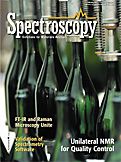Article
Spectroscopy
Spectroscopy
Spectroscopy-02-01-2003Volume
FT-IR and Raman Microscopy on a United Platform: A Technology Whose Time Has Come (pdf)
A "Technical Note" article.
Articles in this issue

The Baseline: Mössbauer Spectroscopy (pdf)
Unilateral Nuclear Magnetic Resonance for Quality Control: The NMR-MOUSE (pdf)
Mass Spectrometry Forum: Chemical Noise in Mass Spectrometry, Part II ? Effects of Choices in Ionization Methods on Chemical Noise (pdf)
FT-IR and Raman Microscopy on a United Platform: A Technology Whose Time Has Come (pdf)
Beginner?s Guide to ICP-MS Part XIV ? Sampling Accessories, Part II (pdf)
Focus on Quality: Validation of Spectrometry Software, Part IV ? Qualification of the Software and System (pdf)
Newsletter
Get essential updates on the latest spectroscopy technologies, regulatory standards, and best practices—subscribe today to Spectroscopy.





